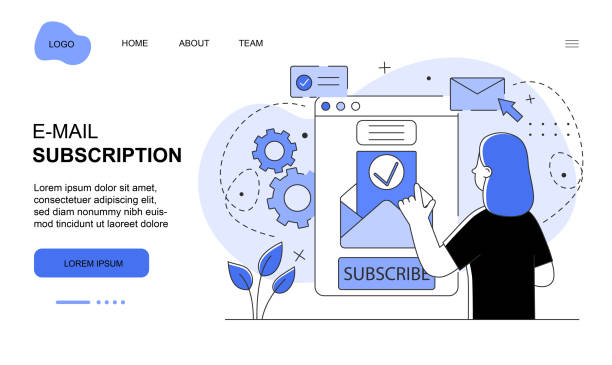What is Responsive Web Design?

In today’s world, where #internet and #websites have become an inseparable part of daily life, the importance of proper #websitedesign is felt more than ever.
Given the countless variety of devices users employ to access web content – from small mobile phones and tablets to laptops and wide desktop monitors – the need for a unified approach to deliver an optimal user experience is crucial.
This is where the concept of Responsive Web Design emerges.
Responsive Web Design is an approach in web design that aims to create websites capable of automatically adjusting their layout and content to the screen size and orientation of the user’s device.
This approach means saying goodbye to the need for creating separate versions of a website for each device.
Instead, by using techniques such as Fluid Grids, Flexible Images, and Media Queries, a website can intelligently adapt itself to any environment.
This adaptability not only improves the user experience but also reduces maintenance costs and allows your website to look professional on any platform.
A deep understanding of this concept is the first step into the advanced world of Responsive Web Design.
Is your online sales not as you expect? With RasaWeb, solve the problem of low sales and poor user experience forever!
✅ Increase visitor-to-customer conversion rate
✅ Create an enjoyable user experience and build customer trust
⚡ Act now to receive a free consultation!
Why is Responsive Design a Necessity?

In the current era, where #mobile has become the primary tool for accessing the internet, responsive web design is no longer a luxury option, but an absolute necessity.
The significant growth in the use of smartphones and tablets for web browsing means that a large portion of your website visitors access your content through these devices.
If your website is not optimized for these users, they will quickly leave and go to your competitors who offer a better user experience.
One of the most important reasons for this necessity is its impact on #SEO and search engine rankings.
Google, as the largest search engine in the world, has explicitly stated that it prioritizes mobile-friendly websites in its mobile search results.
This means that if your website is not responsive, the likelihood of being seen in mobile searches significantly decreases.
In addition to SEO, #userexperience (UX) also plays a vital role.
A mobile-compatible website provides faster loading, easier navigation, and better readability across different screen sizes, all of which lead to increased user satisfaction and reduced Bounce Rate.
Ignoring responsive web design means losing a large segment of potential audience and harming your business’s online credibility and success.
For this reason, every website seeking success and sustainability in the digital space must be committed to responsive web design.
Principles and Fundamentals of Responsive Website Design

To deeply understand responsive web design, familiarity with its principles and fundamentals is essential.
These principles are the main pillars that allow a website to display correctly on any screen size.
The three key principles in responsive design are:
-
Fluid Grids: Instead of using fixed pixel units for element widths, fluid grids use relative units such as percentages.
This causes the website layout to automatically expand or contract with changes in screen size, and content is always displayed proportionally to the available space. -
Flexible Images: Images, like other elements, must be able to resize.
By setting the maximum width (max-width) of images to 100 percent, it is ensured that the image never overflows its container and is always displayed at an appropriate size for the user’s device, without becoming pixelated or excessively large. -
Media Queries: This is the most powerful tool in responsive web design.
Media queries allow you to apply different CSS styles based on specific device characteristics, such as screen width, height, orientation, and screen type (screen or print).
For example, you can define that on small screens, columns stack vertically instead of side-by-side, or font sizes change.
These three principles together form a powerful system that enables the creation of a seamless and optimized user experience across all devices.
Correct implementation of these fundamentals lays the groundwork for a successful responsive web design.
Below is a table comparing fixed and fluid layouts:
| Feature | Fixed Layout | Fluid/Responsive Layout |
|---|---|---|
| Measurement Unit | Pixel (px) | Percentage (%), em, rem, vw, vh |
| Device Compatibility | Low (only for a specific size) | High (compatible with a wide range of sizes) |
| User Experience | May be disrupted on different devices | Optimized and consistent across all devices |
| Implementation Complexity | Simpler (in the past) | More complex (requires responsive thinking) |
| Maintenance | May require separate versions | Maintaining a single codebase |
| SEO | Weaker on mobile | Better, according to Google standards |
Key Tools for Implementing Responsive Design

For efficient and fast #responsive_web_design, using the right tools is highly important.
These tools facilitate the development process and help designers and developers build high-performance, multi-device compatible websites.
-
CSS Frameworks: Frameworks like Bootstrap and Tailwind CSS have become popular choices for responsive web design due to their flexible grid systems, pre-built UI components, and utility classes.
Bootstrap, with its component-oriented approach, allows for rapid UI construction, while Tailwind CSS, with its “utility-first” philosophy, provides more freedom for custom styling. -
CSS Preprocessors: Tools such as Sass and Less, by adding features like variables, functions, and nesting to CSS, help in better management and more efficient coding for responsive web design.
These tools make CSS code more readable, maintainable, and scalable. -
Browser Developer Tools: Built-in tools in browsers like Chrome (Chrome DevTools) and Firefox (Firefox Developer Tools) are essential for testing and debugging #responsive_design.
These tools allow simulating various screen sizes, inspecting media queries, and observing style changes in real-time. -
Content Management Systems (CMS): Platforms like WordPress and Joomla simplify the process of building responsive websites for users with less coding knowledge by offering responsive themes and plugins.
Many modern WordPress themes are built from the ground up for responsive web design. - Online Responsive Testing Tools: Websites like Responsive Design Checker and Am I Responsive? allow you to simultaneously view your website’s display on multiple devices and identify potential weaknesses in your adaptive web design.
Intelligent use of these tools can accelerate the responsive web design process and help create unparalleled user experiences.
Does your company’s website perform as well as your brand deserves? In today’s competitive world, your website is your most important online tool. RasaWeb, specializing in professional corporate website design, helps you to:
✅ Gain credibility and customer trust
✅ Convert website visitors into customers
⚡ Get a free consultation now!
Challenges and Solutions in Responsive Website Design

Although #responsive_web_design offers numerous advantages, its implementation is not without challenges.
#Developers often encounter issues that require creative and specialized solutions.
Here are some of the most common challenges and ways to address them:
-
Performance and Loading Speed: Responsive websites can load slowly if not properly optimized, especially on mobile devices with poor internet connections.
Solution: Image optimization (compression and use of appropriate formats like WebP), Lazy Loading for off-screen content, Minification of CSS and JavaScript files, and using Content Delivery Networks (CDNs) can help improve performance.
In responsive web design, loading speed is crucial. -
Content Prioritization: Deciding which content to display on smaller screens and how to arrange it can be challenging.
Solution: Adopt a “Mobile-First” approach; first design the essential and critical content for mobile, then expand it for larger screens.
This helps you focus on the core user experience. -
Complex Navigation: Extensive and complex menus on a desktop screen may be confusing and unusable on mobile.
Solution: Use mobile-friendly navigation patterns such as Hamburger Menus, Off-Canvas Menus, or Tabbed Navigation that optimize space.
-
Testing and Debugging: Testing a website across a wide range of devices and screen sizes is time-consuming and challenging.
Solution: Use browser developer tools, device emulators, and online testing services (like BrowserStack) to ensure the correct functioning of responsive web design in any environment.
-
Touch Interactions: Designing for touch devices requires attention to button size, spacing between elements, and gestures.
Solution: Ensure that clickable elements have a minimum size of 48×48 pixels and sufficient spacing between them so users can easily tap them with their fingers.
By understanding these challenges and implementing appropriate solutions, responsive web design can be successfully implemented, providing an unparalleled experience for users on any platform.
The Impact of Responsive Design on SEO and Ranking

In today’s digital world, #SEO plays a vital role in the success of a website.
Google and other search engines are constantly striving to provide the best user experience to their audience, and this includes delivering results that are easily viewable and usable on various devices.
This is where the importance of responsive web design for #SEO becomes evident.
The first and most important impact relates to Google’s “Mobile-First Indexing” policy.
Since 2018, Google has officially announced that it uses the mobile version of websites as the basis for ranking and indexing.
This means that if your website does not have a responsive design and does not display well on mobile devices, even if your desktop version is excellent, your ranking in search results will suffer.
Google recognizes a responsive website as a single website that requires less crawling and indexing, which in itself is an SEO advantage.
Furthermore, responsive web design also positively affects user behavior factors that influence SEO.
When users have a positive experience on your website (such as fast loading, easy navigation, and good readability), the Bounce Rate decreases and Dwell Time increases.
These signals tell search engines that your website has valuable content and should rank better.
Conversely, a non-responsive website that is difficult to use on mobile leads to user frustration, increased bounce rate, and ultimately a decrease in SEO ranking.
In summary, mobile-friendly web design is crucial not only for user experience but also for your SEO strategy and online visibility.
Investing in responsive web design is an investment in the future success of your online presence.
Review of Successful Responsive Website Design Examples

To better understand the concept and practical application of responsive web design, nothing is better than reviewing successful examples.
These websites have not only implemented responsive principles well but have also managed to provide a flawless user experience across all devices.
Here are some of the key features observed in these examples:
-
New York Times: This website was one of the pioneers in responsive web design.
Their design ensures that content (articles, images, videos) adjusts flawlessly and legibly to any screen size.
Simple and accessible navigation, and fast loading even with rich content, are among its strengths. -
Smashing Magazine: This popular online magazine for web designers and developers is itself a prime example of excellent responsive web design.
They use complex media queries to optimize readability and user experience on various devices without sacrificing website performance. -
Shopify: The e-commerce platform Shopify is a good example of how to implement responsive design in complex websites with buying and selling capabilities.
Product pages, shopping cart, and checkout process all function smoothly and user-friendly on both mobile and desktop. -
Slack: This popular communication tool is a great example of a web application that works well on any device.
Its user interface intelligently adapts to screen size and maintains a consistent user experience.
These websites demonstrate how by focusing on content, navigation simplicity, and loading speed, a successful responsive web design can be implemented.
The key lesson from these examples is that adaptive web design is not just about resizing; it’s about optimizing the overall user experience in any environment.
The table below shows common features in these successful designs:
| Feature | Description | Importance in Responsive Design |
|---|---|---|
| Fluid Layout | Using relative units (percentage, em, rem) for dimensions | Allows content to dynamically adapt to screen size. |
| Optimized Images | Compression, using srcset attribute, lazy loading | Reduces loading time, prevents excessive data consumption. |
| Smart Media Queries | Using appropriate breakpoints for different devices | Applies specific styles to optimize display on different sizes. |
| User-friendly Navigation | Simple and accessible menus on mobile (e.g., hamburger) | Increases usability and reduces complexity on small screens. |
| High Performance | Optimized code, resource compression, using CDN | Reduces bounce rate, improves SEO, increases user satisfaction. |
| Touch Capability | Interactive elements with appropriate size and spacing for finger touch | Improves user experience on touch devices. |
The Future of Responsive Website Design and Emerging Trends

The world of the web is constantly evolving, and responsive web design is no exception.
With the advent of new technologies and changing user habits, the future of #responsive_web_design is intertwined with exciting trends that will further enhance the user experience.
One of the most important upcoming trends is #Progressive_Web_Apps (PWAs).
PWAs provide a user experience similar to a native application through a web browser.
They offer capabilities such as offline work, Push Notifications, and Add to Home Screen, all made possible by responsive web design and modern web technologies.
PWAs blur the line between websites and native applications, shaping the future of #web_development.
Another trend is the emergence of new user interfaces such as #Voice_User_Interfaces (VUIs) and Artificial Intelligence (AI).
With the proliferation of voice assistants and smart speakers, websites must be optimized not only for visual display but also for voice interactions.
Responsive web design should include considerations for how information is presented audibly and how to react to voice commands.
Additionally, attention to Dark Mode as a popular feature in responsive web design is increasing.
This feature is not only beneficial for user eye comfort in low-light environments but can also reduce battery consumption on devices with OLED screens.
Implementing Dark Mode responsively and based on user system settings has become an important part of responsive web design.
Finally, the focus on #Performance and Google’s Core Web Vitals will remain a priority.
Websites must load quickly even on low-end devices and with slow internet speeds.
This requires deep optimization of images, fonts, and code.
The future of responsive web design is moving towards smarter, faster, and more adaptable websites with every type of interaction.
Does your current website build the trust that potential customers should have in your business? If the answer is no, it’s time to have your professional and impactful corporate website with RasaWeb.
✅ Fully custom design tailored to your brand identity
✅ Increase lead generation and business credibility in customers’ eyes⚡ Contact us for a free consultation!
Golden Tips for Optimizing User Experience in Responsive Design

Responsive web design is not just about adjusting element sizes; its most important goal is to provide an unparalleled and consistent #user_experience (UX) across all devices.
To achieve this goal, adherence to several golden tips is crucial:
-
Mobile-First Approach: Instead of designing for desktop and then attempting to shrink it for mobile, first design for the smallest screen (mobile).
This method helps you focus on the most essential content and functionality and prevents information overload on small screens.
You can then gradually add more features and content for larger screens.
This thinking is the foundation of successful responsive web design. -
Appropriate Size for Interactive Elements: Buttons, links, and other clickable elements should be large enough to be easily touched with a finger.
The minimum recommended size for a touch target is usually 48×48 pixels.
Also, ensure there is enough space between these elements to prevent accidental clicks. -
Readability Across Different Sizes: Font size and line length should be optimized across different devices.
Fonts that are too small or lines that are too long (more than 80 characters on desktop or 45-75 on mobile) can make reading difficult.
Use relative units like `em`, `rem`, or `vw` for font sizes to ensure they adjust automatically. -
Optimized Images and Videos: Images should be compressed, and the `srcset` or `picture` attribute should be used to provide different versions of the image based on screen size.
Videos should also be responsive and prevent excessive data loading. -
Continuous Testing: Continuously test your website on various physical devices and browser emulators.
Browser developer tools are also very useful for this purpose.
This helps identify navigation, layout, or performance issues that might otherwise remain hidden in a responsive web design. -
Simple and Clear Navigation: Menus should be compactly displayed on mobile (like a hamburger menu), and users should be able to easily access the information they need.
The navigation hierarchy should be logical and understandable.
By following these tips, you can ensure that your responsive web design is not only technically sound but also provides a truly enjoyable and efficient user experience for all visitors, regardless of the device they use.
This approach means adaptive web design that meets the real needs of users.
Conclusion and Why You Should Consider Responsive Design Now?

As extensively discussed throughout this article, responsive web design is no longer a competitive advantage but an industry standard and an absolute necessity for any website seeking success and sustainability in today’s digital space.
From the continuous increase in mobile device usage for internet access to its direct impact on SEO and search engine rankings, there are numerous reasons to implement a responsive web design.
We saw how fundamental principles like fluid grids, flexible images, and media queries allow websites to intelligently adapt to any screen size.
Also, by examining challenges and providing solutions, it became clear that with the right approach, potential obstacles can be overcome to provide a flawless user experience.
Successful examples from major companies like The New York Times and Shopify also demonstrated how responsive web design can contribute to the scalability and success of businesses.
The future of the web, with trends like PWAs, voice user interfaces, and dark mode, is also moving towards even richer and more immersive user experiences, all based on responsive web design.
Investing in responsive web design means investing in greater accessibility, improved SEO, increased conversion rates, and ultimately, higher user satisfaction.
This is not just a technical decision but a strategic one for survival and growth in the competitive online ecosystem.
Therefore, if your website is not yet fully responsive, now is the time to make this change.
This action will not only help your website stand out among the vast number of websites but also ensure that your audience, regardless of the device they use, has the best possible experience interacting with your brand.
Frequently Asked Questions
| Question | Answer |
|---|---|
| What is Responsive Web Design? | It is a method for designing and implementing websites that automatically adjusts the layout and content of the display based on the user’s device screen size (desktop, tablet, mobile, etc.) to display it in the best possible way. |
| Why is responsive design important? | With the increasing use of various devices to access the web, a responsive site improves user experience, reduces bounce rate, strengthens site SEO, and makes site management and maintenance easier (instead of having separate versions for mobile and desktop). |
| How does responsive design work? | This type of design uses techniques such as flexible grids and layouts (Flexbox, CSS Grid), flexible images and media, and most importantly, CSS Media Queries to change page styles and layouts based on screen characteristics (width, height, resolution, etc.). |
| What are the main tools for implementing responsive design? | The main tools include HTML5 (for content structure), CSS3 (especially Media Queries, Flexbox, Grid for responsive styling and layout), and sometimes JavaScript for more complex interactions. |
| What are the main benefits of using responsive design? | The main benefits include increased user accessibility (covering a wide range of devices), improved user experience, improved site ranking in search engines (especially Google), reduced development and maintenance costs, and increased visitor-to-customer conversion rates. |
And other services of Rasa Web Advertising Agency in the field of advertising
- Smart Data Analysis: Designed for businesses seeking customer behavior analysis through Google Ads management.
- Smart Data Analysis: A fast and efficient solution to increase sales, focusing on attractive UI design.
- Smart Advertising Campaign: A professional solution for customer behavior analysis, focusing on intelligent data analysis.
- Smart Sales Automation: Transform campaign management with the help of Google Ads management.
- Smart Customer Journey Map: A combination of creativity and technology for analyzing customer behavior through user experience customization.
And over hundreds of other services in internet advertising, advertising consultation, and organizational solutions
Internet Advertising | Advertising Strategy | Advertorial
Resources
Comprehensive Guide to Responsive Design
Responsive Website Design Tutorial
What is Responsive Web Design?
What is Responsive Design?
? To reach the pinnacles of success in the online world, RasaWeb Digital Marketing Agency is your smart business companion. With our expertise, SEO-optimized website design is no longer a dream, but a high-yield reality.
📍 Tehran, Mirdamad Street, next to Bank Markazi, Kazeroon Jonubi Alley, Ramin Alley, No. 6




